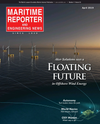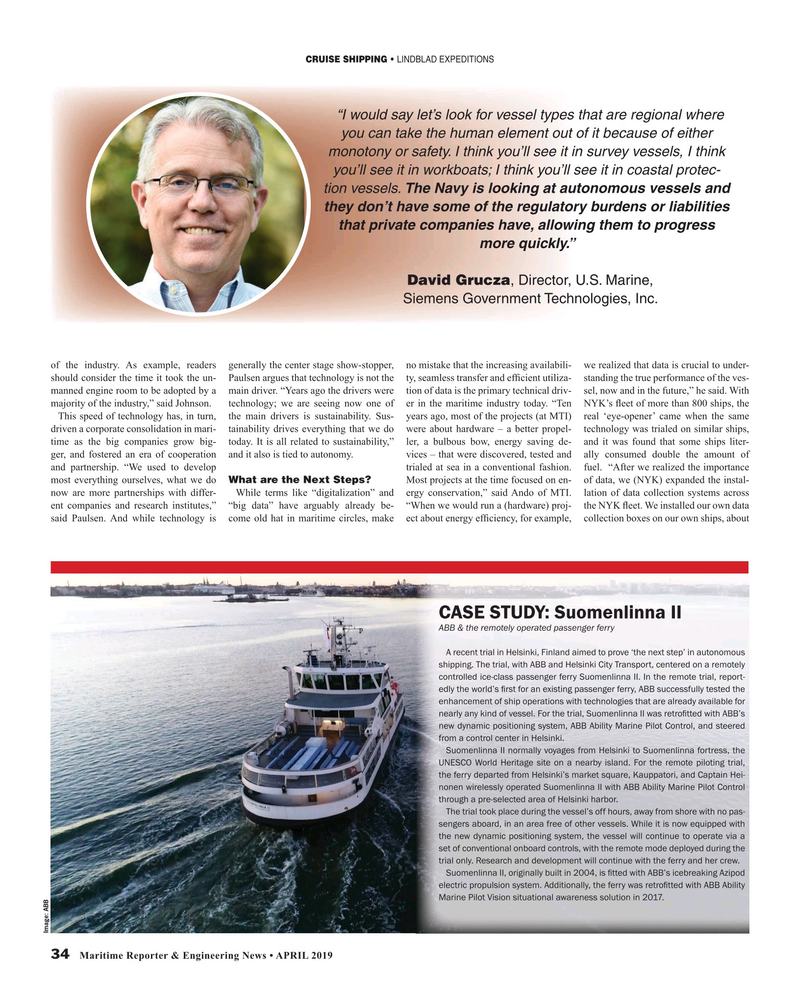
Page 34: of Maritime Reporter Magazine (April 2019)
Navies of the World
Read this page in Pdf, Flash or Html5 edition of April 2019 Maritime Reporter Magazine
CRUISE SHIPPING • LINDBLAD EXPEDITIONS “I would say let’s look for vessel types that are regional where you can take the human element out of it because of either monotony or safety. I think you’ll see it in survey vessels, I think you’ll see it in workboats; I think you’ll see it in coastal protec- tion vessels. The Navy is looking at autonomous vessels and they don’t have some of the regulatory burdens or liabilities that private companies have, allowing them to progress more quickly.”
David Grucza, Director, U.S. Marine,
Siemens Government Technologies, Inc.
of the industry. As example, readers generally the center stage show-stopper, no mistake that the increasing availabili- we realized that data is crucial to under- should consider the time it took the un- Paulsen argues that technology is not the ty, seamless transfer and ef? cient utiliza- standing the true performance of the ves- manned engine room to be adopted by a main driver. “Years ago the drivers were tion of data is the primary technical driv- sel, now and in the future,” he said. With majority of the industry,” said Johnson. technology; we are seeing now one of er in the maritime industry today. “Ten NYK’s ? eet of more than 800 ships, the
This speed of technology has, in turn, the main drivers is sustainability. Sus- years ago, most of the projects (at MTI) real ‘eye-opener’ came when the same driven a corporate consolidation in mari- tainability drives everything that we do were about hardware – a better propel- technology was trialed on similar ships, time as the big companies grow big- today. It is all related to sustainability,” ler, a bulbous bow, energy saving de- and it was found that some ships liter- ger, and fostered an era of cooperation and it also is tied to autonomy. vices – that were discovered, tested and ally consumed double the amount of and partnership. “We used to develop trialed at sea in a conventional fashion. fuel. “After we realized the importance most everything ourselves, what we do What are the Next Steps? Most projects at the time focused on en- of data, we (NYK) expanded the instal- now are more partnerships with differ- While terms like “digitalization” and ergy conservation,” said Ando of MTI. lation of data collection systems across ent companies and research institutes,” “big data” have arguably already be- “When we would run a (hardware) proj- the NYK ? eet. We installed our own data said Paulsen. And while technology is come old hat in maritime circles, make ect about energy ef? ciency, for example, collection boxes on our own ships, about
CASE STUDY: Suomenlinna II
ABB & the remotely operated passenger ferry
A recent trial in Helsinki, Finland aimed to prove ‘the next step’ in autonomous shipping. The trial, with ABB and Helsinki City Transport, centered on a remotely controlled ice-class passenger ferry Suomenlinna II. In the remote trial, report- edly the world’s ? rst for an existing passenger ferry, ABB successfully tested the enhancement of ship operations with technologies that are already available for nearly any kind of vessel. For the trial, Suomenlinna II was retro? tted with ABB’s new dynamic positioning system, ABB Ability Marine Pilot Control, and steered from a control center in Helsinki.
Suomenlinna II normally voyages from Helsinki to Suomenlinna fortress, the
UNESCO World Heritage site on a nearby island. For the remote piloting trial, the ferry departed from Helsinki’s market square, Kauppatori, and Captain Hei- nonen wirelessly operated Suomenlinna II with ABB Ability Marine Pilot Control through a pre-selected area of Helsinki harbor.
The trial took place during the vessel’s off hours, away from shore with no pas- sengers aboard, in an area free of other vessels. While it is now equipped with the new dynamic positioning system, the vessel will continue to operate via a set of conventional onboard controls, with the remote mode deployed during the trial only. Research and development will continue with the ferry and her crew.
Suomenlinna II, originally built in 2004, is ? tted with ABB’s icebreaking Azipod electric propulsion system. Additionally, the ferry was retro? tted with ABB Ability
Marine Pilot Vision situational awareness solution in 2017.
Image: ABB 34 Maritime Reporter & Engineering News • APRIL 2019
MR #4 (34-41).indd 34 4/2/2019 12:45:37 PM

 33
33

 35
35
